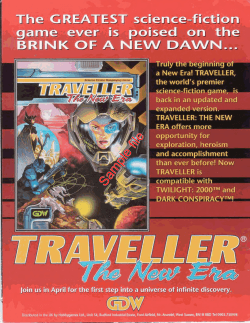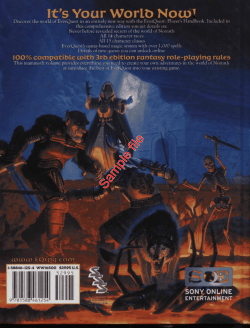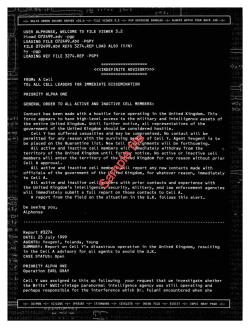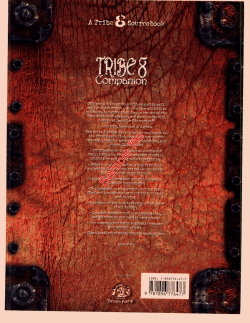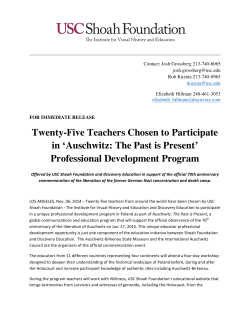
Sample file by Jonathan Blacke and Robert Hatch Foreword by Janet Berliner
file ple m Sa by Jonathan Blacke and Robert Hatch Foreword by Janet Berliner Table of Contents 1 Sa m ple file Never Again 2 Charnel Houses of Europe: The Shoah file ple m Sa Table of Contents 3 Special Thanks Credits Authors: Jonathan Blacke and Robert Hatch Foreword by: Janet Berliner Additional Writing by: Richard E. Dansky Developer: Richard E. Dansky Editor: Ronni Radner Art Directors: Lawrence Snelly Art by: Larry MacDougal, Andrew Ritchie, George Pratt Cover Design: Matt Milberger and Lawrence Snelly Layout and Typesetting by: Matt Milberger Cartography by: Larry Friedman Translation Assistance: Karsten Esser Note: The information in this book supercedes anything published in Berlin By Night. Sa m ple file Apologies to George Guthridge, co-author of Child of the Light, Child of the Journey, and Children of Dusk. The developer would like to thank the following people, without whom the completion of this book would have been impossible: Robert Hatch and Jonathan Blacke, for taking on such a strenuous and important project, and for all of their hard work, research and dedication to this book. Janet Berliner, for agreeing to be a part of this project, but more importantly, agreeing to listen the very first time I dared to call her. Irene, Saul, Marla and Rebecca Dansky, for the support and resources you never shirked from offering. Ronni Radner, Greg Fountain, Phil Brucato, Ethan Skemp, Ian Lemke, Kathy Ryan, Cynthia Summers, Ken Cliffe, Lawrence Snelly, Stewart Wieck and all of the other individuals at White Wolf who have supported this project from its inception. Thank you for allowing me to do this, and for helping me along the way. Jennifer Hartshorn, for the first steps on the road. The teachers and rabbis of congregations Temple Judea and Keneseth Israel, for planting the seeds that flowered into this book. Wendy Blacksin, for looking at the manuscript when I needed another critical eye. Art Spiegelman, creator of Maus, who demonstrated that it can be done. And everyone else out there who ever gave a damn about what happened — you know who you are. © 1997 White Wolf, Inc. All rights reserved. Reproduction without the written permission of the publisher is expressly forbidden, except for the purposes of reviews. White Wolf is a registered trademark of White Wolf, Inc. All rights reserved. Wraith the Oblivion, Black Dog Game Factory and Charnel Houses of Europe The Shoah are trademarks of White Wolf, Inc. All rights reserved. All characters, names, places and text herein are copyrighted by White Wolf, Inc. The mention of or reference to any company or product in these pages is not a challenge to the trademark or copyright concerned. Because of the mature themes involved, reader discretion is advised. Check out White Wolf online at http://www. white-wolf.com; alt.games.whitewolf and rec.games.frp. storyteller 4 Charnel Houses of Europe: The Shoah Dedication This book is dedicated to the survivors of the Holocaust, who have spent 50 years telling their stories. What you hold in your hands is a tribute to their perseverance, and in some small way an attempt to carry on their legacy for the sake of the generations who will never know them. Todah raba. Charnel Houses of Europe: The Shoah is the second offering of Wraith: The Oblivion Sourcebooks under the Black Dog aegis. This book is to be sold to individuals 18 or older only. The material contained within this book is intended for mature gamers only, and has the potential to offend or disturb. Please exercise discretion in the use of the material in Charnel Houses of Europe, as some people may find its content or subject matter to be objectionable. If you or your players cannot handle the intensity or subject matter of this book, please put it back on the shelf. file ple Table of Contents 7 13 17 21 41 59 75 93 Sa m Foreword: Mi Yagid Labanim Ghost Story: The Rusalka Introduction The Telling of the Agonies: A Chronicle of the Millions An Antechamber of the Damned: The Theresienstadt Ghetto Behind the Wall: The Ghetto at Warszawa A Struggle for the Forsaken: Babi Yar Behind the Wire: Oswiecim (Auschwitz-Birkenau) Table of Contents 5 ple m Sa file file Mi Yagid Labanim: Who Will Tell the Children? Sa m ple by Janet Berliner ecently, I wrote a story about a girl named Jennie, a contemporary Jewish American teenager who was forced to face her heritage. Her response, at least initially, was a feeling that she was being put upon. She had nothing to do with the past. She was not involved. It’s not my problem. All of that stuff happened ages ago. Why rehash ancient history? Forget it already. Forget it? Forget prejudice, violence, ethnic strife, genocide? I don’t think so. So what do we do to ensure that our children and their children and their children remember? For if they do not re- member, the attempt to make it happen again will be repeated, as it has been this decade in Rwanda. Which group will be singled out the next time around? Redheads, perhaps, or blue-eyed blondes? It’s not the “N word” or the “J word,” or what’s politically correct and what’s not that matters. It’s learning that we are setting each other apart without regard for human dignity and making it possible for genocide to reoccur when we say things like, “There’s a black man at the door,” instead of “There’s a man at the door,” or “I bought the car at a great price. Boy, did I Jew him down.” Again I ask, what do we do about it? What can we do about it? The answer is that we must do what we can, each in our own way — in short stories, in essays, in poetry and novels, Mi Yagid Labanim: Who Will Tell the Children 7 “Hello,” I said, idly turning the photograph over. The script on the back was tiny, fine and faded. I used a magnifying glass to read it: Siegfried Lichtenstein. Born 1880. An officer in the Kaiser’s Army. Mostly invalid after the war. Applied to go to Johannesburg, but stayed in Regensburg, Bavaria, when his wife was refused a visa. He thought that he was safe, what with half the bones missing in his face. He was one of the first to be deported. Hedwig Lichtenstein. Born 1882. Married Heimann. Lived in Regensburg. Immigrated to Melbourne, Australia. Died 1968. Erna Lichtenstein. Born 1886. Lived in Berlin. Deported to Theresienstadt in 1938 and died in the gas chamber. Ella Lichtenstein. Born 1888. Married Joseph Kahn. In 1932, the family with two children immigrated to Amsterdam, Holland. In 1939, the husband was taken to a workcamp, the children to an unknown destination (“For their safety”) and their eight-roomed home was filled with Nazis for whom Ella had to keep house. (I was there in 1960. The neighbors told me that Ella was taken to Auschwitz in 1942.) My darling wife, Recha Lichtenstein. Born 1887. Married James Abraham. Arrived safely Cape Town, South Africa, 13th June, 1936. Sa m ple file often using magic realism to define truths too painful and ugly to be faced in any other form. Each time I complete a piece of work, I think — I hope — that I am done with it. That I have paid my dues. But for some things the dues can never fully be paid. In a sense, it is like the bodily functions that most of us perform daily. Each day, having performed them, we feel relief. We feel clean. And then the offal begins to gather once more and as surely as night follows day, the pressing need for elimination returns. So it is with my creative bowels. When I think that I have written enough, I discover that I must write more. And while I do, I question if that is in fact the answer to educating our children’s children. The survivors are old. Their children are growing old. Their grandchildren say it is not their problem. Many of them do not know about their roots; still more do not care. What, I ask myself, will work to educate and inform the children of the new millennium? Will they read William Styron’s Sophie’s Choice, will they watch Vittorio de Sica’s The Garden of the Finzi-Continis, or do we have to feed them horrors in some form that makes it palatable for them? If we give them a Holocaust Web site, will it serve as a tool of awareness, or will it simply turn evil into a game? Before Steven Spielberg made Schindler’s List, I was told repeatedly that no one wanted to hear about the Holocaust. That wasn’t true, was it? His film was a box-office smash, even in Germany. Why does that surprise me? Because I was in Berlin in the ‘70s when the government insisted that all schoolchildren watch a documentary on Hitler. The children stomped and sang along and complained, asking why they too could not march and sing and have “that kind of fun.” I was there in the ‘80s when groups of German children were taken to visit the sites of concentration camps and complained because they were not able to see the machinery in action. I was there in the ‘90s when a game was developed that invited the participants to devise better ways of ridding the world of Jews. On the day that Richard Dansky called to ask me to write this essay, I had written the last scene of the third book in a trilogy of Holocaust novels. I was going through my research materials, packing them away with a sense of relief, when the telephone rang. As I lifted the receiver, I held in one hand a precious sepia photograph, the one that gave birth to Jennie’s story. The photograph — of my grandmother with her older brother and three sisters — was taken sometime around 1929. The glass had cracked, so I was removing the photograph in order to put it into a new frame. 8 Charnel Houses of Europe: The Shoah Recha Lichtenstein Abraham. My adored grandmother. The storyteller of the family, saved and brought to South Africa through the ingenuity of my mother — her youngest daughter.... I heard what Richard said on the phone that day through the keening voices of the collective unconscious of the dead — my own family and the family of humanity. Richard explained earnestly what it was he was trying to do. file Sa m ple I started to argue, to say that the Holocaust was not a game, but a voice inside my head stopped me. We must teach them through the tools with which they are comfortable, it said. Once upon a time, I thought, there were bards and storytellers who passed on the words of the elders around campfires. Then came the era when the pen was mightier than the sword. But there are few bards now, and as we approach the millennium, the pen diminishes in power. While Richard waited patiently for my answer, I recalled a day I spent in Nice, in an old stone building overlooking the Mediterranean. As if it were happening again, I saw myself being handed a trust by my great-uncle, a Holocaust survivor who had nary an organ fully intact. Our conversation switched back and forth between six languages, only five of which I fully understood — something he did out of old habit from his concentration-camp days when such devices were some protection from eavesdroppers. He gave me a copy of La Deportation. The book was a compilation of black-and-white photographs which had recently been released from the French government’s archives. They were stark and unembellished by text, snapshots taken by German guards and “technicians” in the camps and sent to their families to show them what their sons and brothers and fathers were doing during their work day. “Take this to America,” my great-uncle said. “Make them publish it.” I hand carried eight copies of that heavy book to the States. For a year, I devoted myself to trying to get it reprinted here. Every copy of the book was stolen from the publishers to whom I sent it. The book was never reprinted here, nor do I have a copy today. My great-uncle is dead. But in my own mind’s eye, those black-and-white photographs, taken with box cameras (the toys of that time) teach the full lesson of the atrocities of which humankind is capable of inflicting. Remembering, I asked Richard to whom he wished me to address this essay. “That’s up to you,” he said. “By whom do you wish most to be heard?” “By the children,” I said, picturing the Children’s Memorial Garden at Yad Vashem. It was there, on the outskirts of Jerusalem, that I had the most profoundly moving experience of my life. “That is my greatest fear — that when my generation is gone, there will be no one left who will tell them the true history of humankind’s darkest moment.” Seven years ago, I flew to Israel to meet Ilan Bar, my halfbrother. He was 44; I had just turned 50. I arrived in Tel-Aviv as Mi Yagid Labanim: Who Will Tell the Children 9 the darkness through a small anteroom in which threedimensional photos of children are exhibited. A railing separates you from a circular floor. The walls and ceiling are a series of convoluted mirrors. Five burning memorial candles are multiplied into tens of millions of pinpricks of light, symbolizing the souls of children who perished. Softly the chant begins…a litany of their names forcing the weight of your body in a circle through the darkness and back out into the stark sunlight. I knew then that even if I lived to be 1000 years old, I could not remove that experience from my consciousness. I wished that I could take each person in the world by the hand and lead them into that hall of lights. Sadly, I cannot do that. So I try to do it with words. From Israel I traveled to Berlin to visit my aged mother, who had returned there to work for Die Mahnung (“The Warning”), the newspaper arm of the League of the Persecuted of the Nazi Regime. Through them, the search for survivors continues, as does vigilance against anti-Semitism. This continuing campaign rests mostly in the hands of an incredible elderly woman, Dr. Rehfeld Waltraud, herself not a Jew, but a lifelong fighter against prejudice and racial injustice. In the newspaper’s small offices in a prewar building on Mommsenstrasse, the battle against Who Cares and It Never Happened goes on. Sa m ple file Yom Kippur was coming to a close. Ilan did not have to identify himself; he looked exactly like my father — his father — had looked when I last saw him, right before his death. I had only seen my father twice, once when I was five and again when I was 17. As for Ilan, I not only had never met him, but until a few weeks before that moment I did not even know that I had a brother. Ilan is a guide. En route to his flat, he told me that he was leaving the following day to take a party of staunch Spanish Catholics on a three-day tour of Jerusalem. Though I speak no Spanish, they had agreed to allow me to come along. I toured the cobbled streets of the Old City, covered my head and arms to enter a mosque and rode a camel into the desert. Then, together with three other brave souls, we drove toward Mount Herzl and the Holocaust Memorial known as Yad Vashem. There is a circular underground structure at Yad Vashem, a memorial built by Abraham and Edita Spiegel of Beverly Hills in memory of their son Uziel, who perished in Auschwitz. It commemorates the one-and-a-half million Jewish children who perished in the Holocaust. One-and-a-half million…1,500,000…children. The memorial hall itself stands in darkness. It is built in much the same way as a Disneyland ride. You walk into 10 Charnel Houses of Europe: The Shoah file ple Sa m Last week, my mother attended a religious service at the rebuilt temple in Oranienburg, near the first of the forced-labor camps. While she was at that service, here in the United States, where all races should be united against bigotry, Reverend Farrakahn was televised spewing hatred at the Jews. In this manner, insanity and entertainment have become interchangeable. We can look at the program guides and choose to do any of the following: Watch the Disney Channel; Watch Discovery; Watch a murder trial; Hear David Duke address his hooded comrades about an all-white Christian America; See Farrakahn, surrounded by his uniformed guards, use rhetoric and mannerisms almost identical to Hitler’s. Those are the facts as I write this, from Las Vegas, where a few nights ago, I (a 5’2" weakling) told a 6’2" truck driver that he would have to refrain from making racial slurs — in this case against Mexicans — or see me in the parking lot. While my challenge stopped the man’s mouth, the incident proved to me again that the battle against the worst of the human spirit is not over. And since that is so, it becomes clear what we must do. While we must not stop talking and writing and making films, we must also be brave enough to make acts of injustice accessible by way of the new mechanics…be it by way of the Internet and CD-ROM, tours of the Museum of Tolerance…or projects like this. Read it and weep. Read it and learn. May it never happen again. — Janet Berliner Las Vegas, NV October, 1996 Mi Yagid Labanim: Who Will Tell the Children 11 ple m Sa file Ghost Story: The Rusalka Sa m ple file by Robert Hatch Show yourself, my people. Emerge, reach out From the miles-long, dense, deep ditches, Covered with lime and burned, layer upon layer, Rise up! Up! From the deepest, bottommost layer! Come from Treblinka, Sobibor, Auschwitz, Come from Belzec, Ponari, from all the other camps, With wide open eyes, frozen cries and soundless screams. — Yitzhak Kacenelson, “The Song of the Murdered Jewish People” Ghost Story: The Rusalka 13
© Copyright 2025

